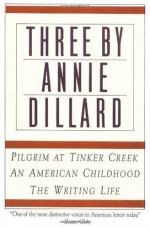|
This section contains 5,617 words (approx. 19 pages at 300 words per page) |

|
SOURCE: "Annie Dillard: Narrative Fringe," in Contemporary-American Women Writers: Narrative Strategies, edited by Catherine Rainwater and William J. Scheick, University Press of Kentucky, 1985, pp. 51-63.
In the essay below, Scheick discusses the narrative structure of Dillard's works and the junctions she creates between elements in her narrative.
We wake, if we ever wake at all, to mystery," says Annie Dillard at the beginning of Pilgrim at Tinker Creek (1974). This remark is a thesis statement, not only for Pilgrim at Tinker Creek but also for Dillard's Tickets for a Prayer Wheel (1974), Holy the Firm (1977), and Teaching a Stone to Talk (1982). So inscrutable is this mystery of creation, Dillard explains, that the best one can do in life is to "discover at least where it is that we have been so startlingly set down, if we can't learn why" (Pilgrim at Tinker Creek): "There is nothing to be done about...
|
This section contains 5,617 words (approx. 19 pages at 300 words per page) |

|


